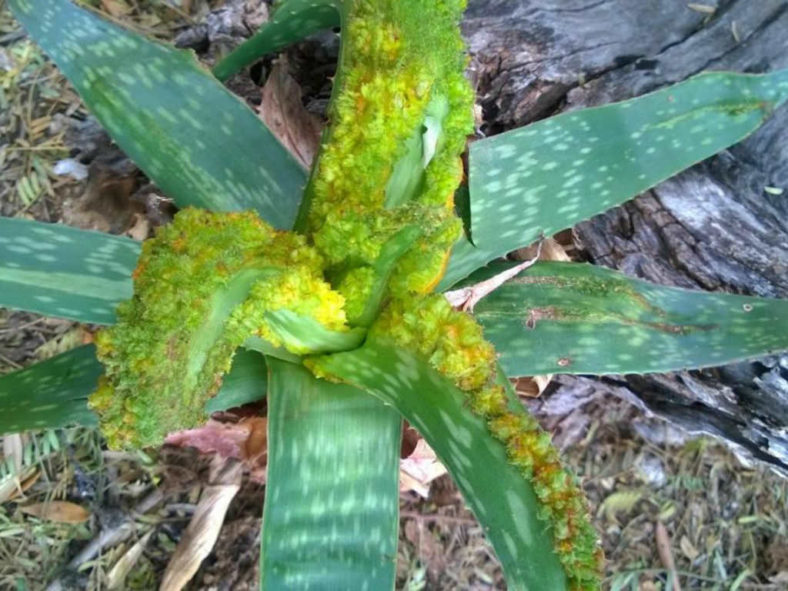Aloe is a large genus of succulent plants that forms rosettes of thick, fleshy leaves and spikes of tubular or bell-shaped flowers in various colors, including cream, yellow, orange, or red. They are native to Africa and the Middle East and grow as easy-care landscape plants in USDA Plant Hardiness Zones 8 to 12, or as houseplants elsewhere. Depending on the species, these succulents range in size from 2 inches (5 cm) to 70 feet (21 m) tall. These drought-tolerant plants prefer well-drained soil and full sun or partial shade. They spread by offsets that grow from the base of the plant.
Although most problems associated with Aloe plants grown as houseplants are bacterial or fungal diseases caused by overwatering, they occasionally get insect pests. Severe damage to some Aloes is caused by Aloe Mite, also known as Aloe Wart Mite or Aloe Gall Mite. It is an eriophyid mite known as Aceria aloinis. Eriophyid mites are tiny and are only visible using a microscope. They are worm-like, with only two pairs of legs, and are poor crawlers; their primary method of population spread is by wind.
You will never see an Aloe Mite crawling around on your Aloes, but you can see the damage it leaves behind. While feeding on plant tissues, this microscopic relative of the spider injects a chemical into the plant that causes masses of warty, tumorous-looking growths on leaves, stems, and flowering stalks. This mass, known as Aloe Cancer, Aloe Wart, or Aloe Gall, often grows around the tiny insects, protecting them from the outside world while they feed on the rapidly growing tissues and lay eggs. Until these strange growths appear on your Aloe, it is impossible to know that the mites are present.

Contact insecticides are useless against Aloe Mites because the little pests reside within the plant's tissues. Some people have reported marginal success with systemic insecticides, but the warty, disfigured growth remains even if the insects are (miraculously) eradicated.
Physical removal is the only effective way to eliminate the galls. Some people recommend cutting growth off the plant and treating the area with a pesticide that kills arachnids, but the plants often continue to grow the unsightly galls, even after the pests and their current growths have been removed.
It is possible to save an irreplaceable Aloe with early detection, removal of galls, and treatment with pesticides, but keeping this plant in your collection risks spreading the tiny insects to other Aloes. Aloe Mites are small enough to travel to new plants on a gust of wind, and treating an infestation can be lengthy, tedious, and expensive.
The best way to protect the rest of your Aloes from becoming infested is to remove any affected plants from your collection as soon as you see warts or galls forming. Place the plants in garbage bags and dispose of them rather than composting them. Once the problematic plants have been removed, consider replacing them with Aloe plants, such as Aloe 'Blue Elf', which are resistant to these pests.
Source: civanonursery.com
Links
- Back to genus Aloe
- Succupedia: Browse succulents by Scientific Name, Common Name, Genus, Family, USDA Hardiness Zone, Origin, or cacti by Genus